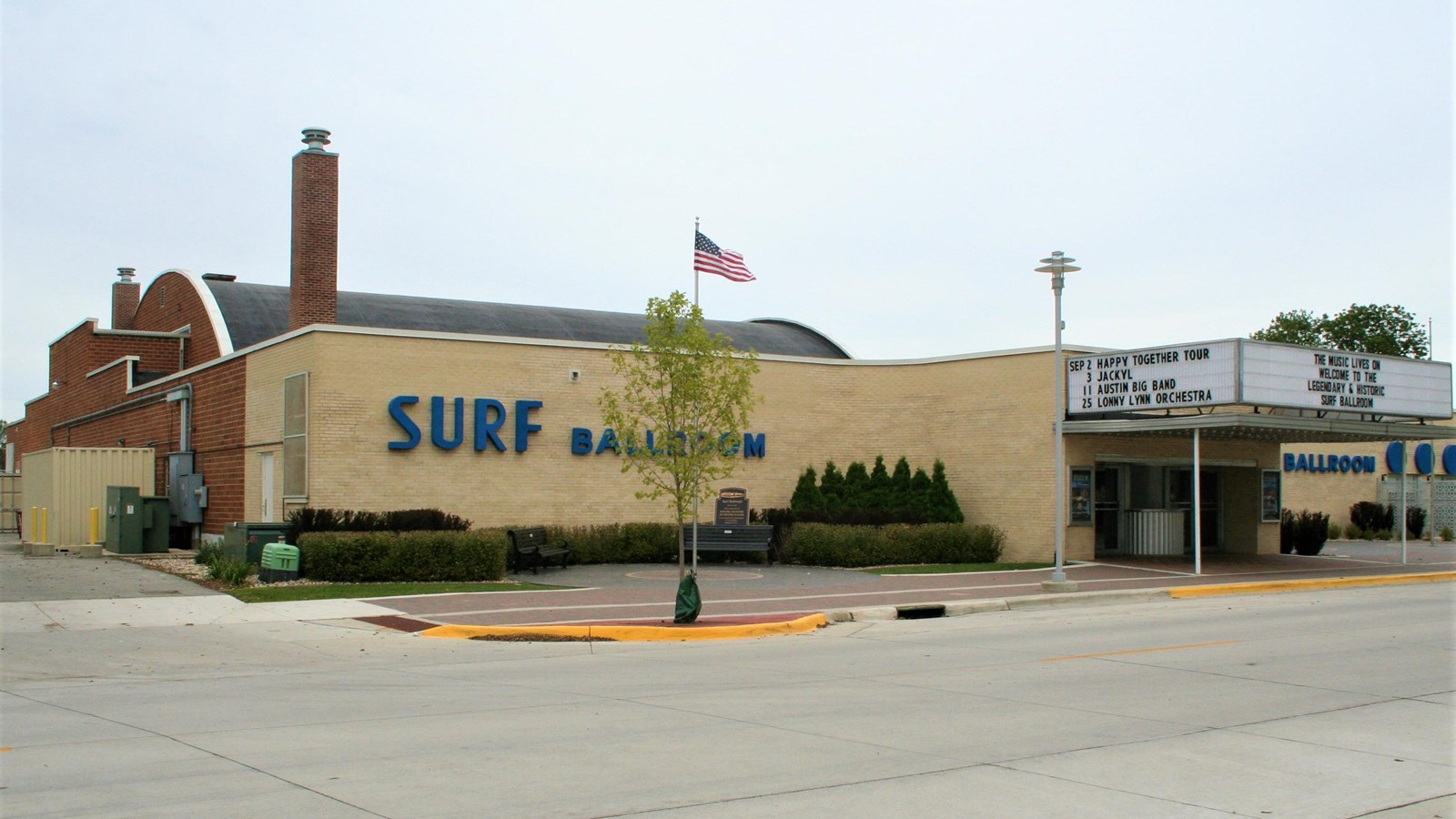Last updated: March 28, 2025
Place
Surf Ballroom

McDowell, 2018
On February 2, 1959 the Surf Ballroom, an indoor concert venue in Clear Lake, Iowa, hosted the last performances of legendary rock performer Buddy Holly, rising star Ritchie Valens, and singer-songwriter J.P. “The Big Bopper” Richardson as part of the Winter Dance Party Tour of 1959. Hours after performing at the Surf Ballroom, Holly, Valens, and Richardson were tragically killed in a plane crash in northern Iowa. Since this famed concert, the Surf Ballroom has become linked to the musical legacy of Holly, Valens, and Richardson and continues to host musical tributes in their honor.
Constructed in 1948 on the site of an earlier ballroom that burned down the previous year, the Surf Ballroom is one of the nation’s most important locations for the history of rock music. Before the Winter Dance Party was even conceived, music fans flocked to the Ballroom to enjoy a diverse array of musical acts. In the 1930s and 1940s, the original Surf Ballroom served as a major Midwestern stop for touring Big Band groups including Count Basie, Duke Ellington, and the Dorsey Brothers. Throughout the 1950s, the new Surf Ballroom provided a welcome venue for rock ‘n’ roll groups touring the region. Early pioneers of popular rock music, including the Everly Brothers, Dion DiMucci, and Conway Twitty, frequented the Surf Ballroom and brought their music directly to the fans that idolized them.
The Winter Dance Party tour was conceived of by early rock pioneer Buddy Holly to revitalize his music career after a break with his former band manager, Richard Petty, placed Holly in dire financial straits. Despite his financial difficulties, Holly’s music career in the late 1950s was taking off and the 22–year-old was one of the most popular rock acts in the nation. Born in Lubbock, Texas to a musical family during the Great Depression, Holly began his career in 1955 as a country and western singer headlining major acts like Elvis Presley on several tours. Holly gained national exposure by appearing on several television and radio programs and switching styles to rock ‘n’ roll. In the winter of 1959, Holly was well known across the nation for hit singles like “Peggy Sue,” “That’ll be the Day,” and “Everyday.”
The Winter Dance Party tour started on January 23, 1959 when Holly, Waylon Jennings, Tommy Allsup, Ritchie Valens, and J.P. “The Big Bopper” Richardson departed from Chicago, Illinois to Milwaukee, Wisconsin to play the Million Dollar Ballroom. The young rockers played several shows throughout Wisconsin and Minnesota for ten days and faced numerous touring challenges including their tour bus breaking down in rural Minnesota in subzero winter temperatures. On Sunday, February 2 Holly and his bandmates arrived in Clear Lake, Iowa where they played for a raucous crowd of over 1,000 teenagers at the Surf Ballroom. Later that evening, Holly, exhausted by the discomforts of touring by road, determined that he and a few of his bandmates would board a small plane to take them to their next show in Moorhead, Minnesota.
A commonly related version of the events that night holds that Tommy Allsup and Ritchie Valens tossed a coin to determine who would fill one of the few seats aboard the small six-seater Beechcraft Bonanza 35 that would ferry the band members to Moorhead. Valens won the toss and Waylon Jennings voluntarily gave up his spot to J.P. Richardson. At approximately 1:03 a.m. on the morning of February 3, 1959, the Beechcraft Bonanza transporting Holly, Valens and Richardson into neighboring Minnesota hit a violent snowstorm and crashed killing all onboard. News of Holly’s death reached Jennings and Allsup only a few hours later in a hotel in Minnesota. Despite the tragedy, the Winter Dance party continued to tour the northern Midwest in honor of their fallen bandmates.
Holly, Valens, and Richardson were mourned across the nation and while their performance at the Surf Ballroom drew only about 1,000 spectators, the concert has been immortalized in cultural memory. Numerous songs and films have dramatized Holly’s life and his last days including, most famously, folk rocker Don McLean’s ballad "American Pie." The Winter Dance Party tour of early 1959 also had a major impact on the course of American rock as it demonstrated the viability and success of rock bands touring the nation to play directly to fans. Today the Surf Ballroom serves as both an active concert venue and a memorial to Holly’s musical legacy with pictures of Holly and memorabilia associated with his life proudly displayed throughout the building.
Sources:
National Historic Landmark Nomination
Amburn, Ellis, 1995
Buddy Holly: A Biography, St. Martin’s Griffin Publishers, New York, NY
National Historic Landmarks (NHLs) are historic places that possess exceptional value in commemorating or illustrating the history of the United States. The National Park Service’s National Historic Landmarks Program oversees the designation of such sites. There are just over 2,500 National Historic Landmarks. All NHLs are also listed in the National Register of Historic Places.
